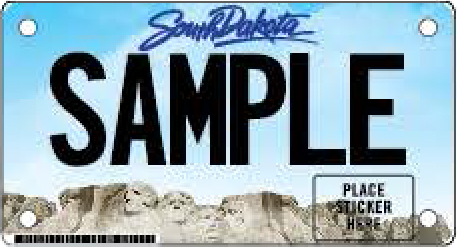

Since stickers were less expensive, less cumbersome, and more theft-resistant than metal tabs, the older format of revalidation made a rapid disappearance as the 1960s drew to a close. Validation stickers were first issued in Canada during 1963, making their appearances in the Maritime provinces of Prince Edward Island and New Brunswick that year. plate stickers predating 1960Ī Stickers issued to late registrants only others received metal tabs. The trend snowballed quickly, with no fewer than six states issuing them before the decade was through: U.S.
South dakota motorcycle plates license#
The first self-adhesive license plate stickers in the United States were issued by Missouri in late 1952, partway through the 1953 expiration year. Delaware, Manitoba, and Nova Scotia also experimented with plate decals during the war. This was the first example of a validation "sticker" in North America.although the decal was not self-adhesive and needed to be soaked in water before use. In 1943, trailers and motorcycles in Ohio were revalidated by a decal that was affixed to the license plate itself. Trailers and motorcycles lacked a windshield to stick things to, however.so alternate means of revalidation had to be used. Some states instead elected to issue windshield decals.

The most common strategy was to issue metal date tabs, proven by Connecticut. Some jurisdictions issued license plates made of fiberboard or other alternate materials, some discontinued front plates in reaction, and many of them revisited the concept of multi-year baseplate use. It was a sign of trends to come.ĭue to metal shortages and rationing concerns during World War II, all states and provinces were forced to look and scramble for ways to save material. Durability concerns were mitigated by the fact that the plates were made of heavy-gauge aluminum with no background paint (making them immune to fading and rust), and the fact that the annual renewal tabs were brittle and difficult to steal helped salve concerns about security. In 1937, Connecticut bucked the prevailing trends and brought out a multi-year base that was designed to be used for many years and validated by annual date tabs from the outset. By 1925, every jurisdiction in North America was issuing annual license plates in embossed steel. Small tabs were difficult to identify for validity at a glance, and easy for thieves to steal. Several states and provinces followed California's lead and experimented with multi-year base use and metal tabs or inserts in the teens and 1920s, but few of them stuck with it for long. The base was intended to be used for four years, and had rivet holes for annual metal tabs to be affixed directly to the license plate itself. In 1916, the state of California issued a porcelain-enamel baseplate. Other states also issued metallic dashboard discs in this era, but used them in conjunction with annual dated plates.

Michigan discontinued discs in 1910, but Nevada, Massachusetts, and New Hampshire experimented with similar systems (sometimes for motorcycles only) through the course of the teens. In 1907 the state of Michigan began to issue dated dashboard discs on an annual basis, displayed in conjunction with an owner-provided multi-year plate. The distant ancestor of the validation sticker was the metallic tax disc, usually fastened to the wooden dashboard of a car. How did it all begin, though? Surprisingly, ancillary means of revalidation have existed for nearly as long as license plates themselves.

Validation stickers on license plates are ubiquitous today, and have been ubiquitous in most states for more than 40 years. License Plate Sticker Colours, Part 1: The Origin of Stickers


 0 kommentar(er)
0 kommentar(er)
